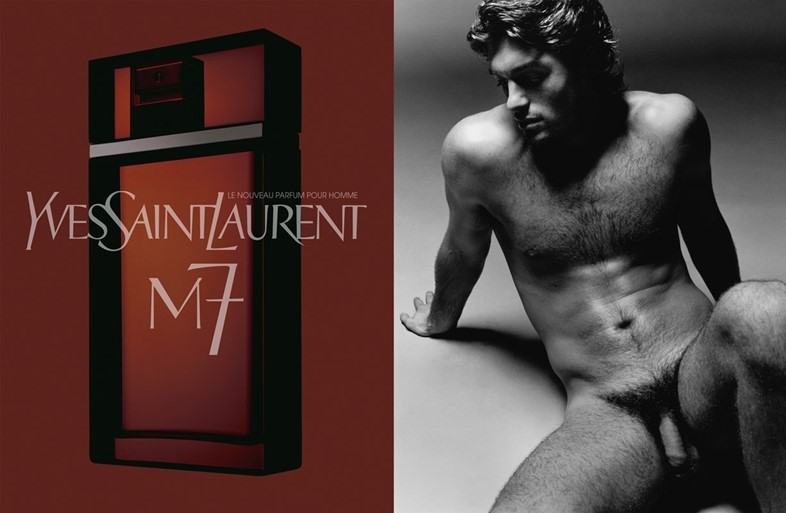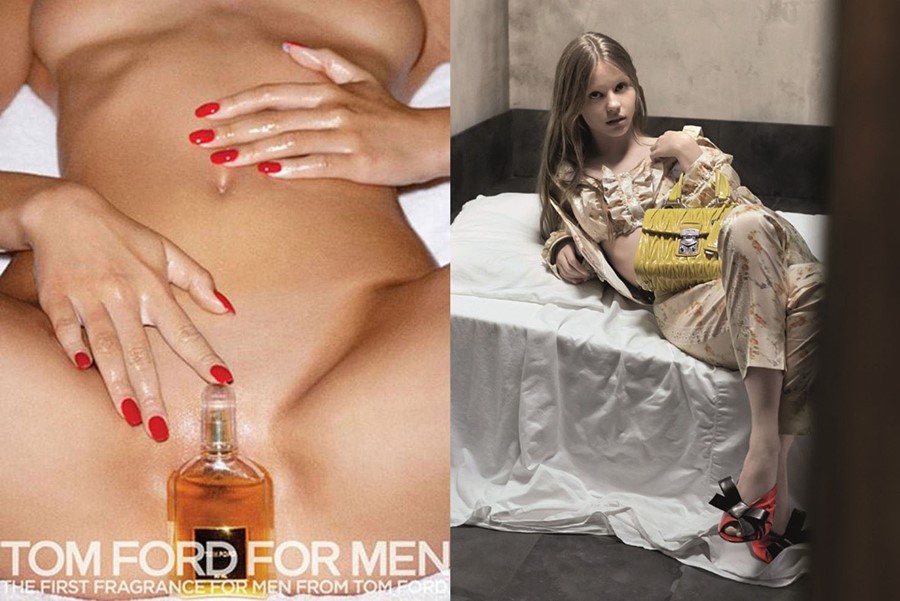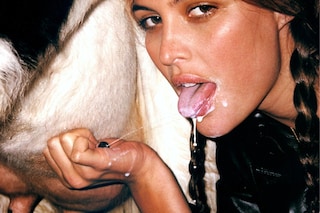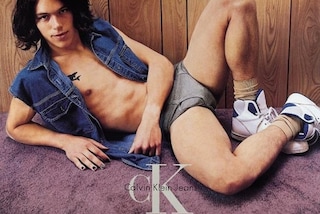Which of these two ads did the Advertising Standards Agency find potentially offensive?
Last week, the Advertising Standards Agency ruled that a Miu Miu campaign image featuring Mia Goth photographed by Steven Meisel was “irresponsible and was likely to cause serious offence”. Although the image of the 22-year-old Nymphomaniac actress might seem harmless – as Zing Tsjeng pointed out, if you were going to complain about something, surely it’d be the film poster for the Lars von Trier flick where she’s in the throes of orgasm – a Vogue reader argued that it showed “a child dressed as an adult in a sexually suggestive pose”. The ASA agreed, feeling that Goth’s youthful appearance, amplified by clothes they claimed were slightly too big and combined with the fact she was alone in a room, was suggestive of child sexualisation and therefore dangerous. “She is 22 and is not dressed provocatively,” argued one Twitter user. “The ASA is throwing a tantrum.”
Of course, it’s far from the first ad to come under fire and be pulled up for the agency’s review – they deal with over 30,000 cases a year. Looking at Tom Ford’s 2007 For Men fragrance campaign shot by Terry Richardson, it’s not hard to see why it too received complaints. A reclining nude model, her skin shining, spreads her legs wide towards the camera, a bottle strategically placed to cover her genitalia while one finger, its nail bright crimson, reaches down to rest on the lid. Another shot showed a bottle wedged between the model’s pushed together breasts, her red lipsticked mouth open, and another featured the bottle lying flat on her mons pubis. Aimed squarely “for men”, its “sex sells” message is so explicit that it demonstrates a sure self-awareness on the part of master provocateur Tom Ford. Ultimately, the image was an easy target to be banned.
So it might be a surprise that it wasn’t. Instead, the 2007 ruling found that the images were “unlikely to cause serious or widespread offence” to readers of the magazines the ad appeared in (GQ and Wallpaper), who Tom Ford argued were discerning enough to recognise its merit as an image, and “that the highly stylised creative treatment gave the ad an artistic quality, not a salacious one.” They used a similar argument at the end of April, when an image featuring a nude Cara Delevingne half submerged in water for their Black Orchid fragrance received complaints, one of which related to it being plastered on a large billboard above Brick Lane. Their claim that “neither [Delevingne’s] pose nor her facial expression were sexually suggestive in any way and that they were classical in nature and had been depicted in art” was enough for the ASA, who again ruled in favour of the brand.

While Miu Miu is a label that channels the power of youthful femininity, for Ford, the man who brought hedonism back into fashion, the erotic is the most potent force. He is, after all, the designer responsible for some of the most remarkable brand turnarounds in history with his visions of unbridled sexuality – his seminal AW95 show for Gucci featuring slinky half-unbuttoned silk shirts literally transformed their fortunes overnight. What’s more, Ford is clued up about the feminist implications of his ads. “I’ve been criticised for objectifying women,” he recently told the Guardian, “But… I’m just as happy to objectify men. The thing is, you can’t show male nudity in our culture in the way you can show female nudity. We’re very comfortable as a culture exploiting women, but not men.” It’s a fair point – we so desensitised to women’s bodies being used to sell products that male nudity in a fashion context is, if anything, comical. A 2002 advert photographed by Sølve Sundsbø that the designer created for Yves Saint Laurent’s M7 fragrance was pulled for featuring a fully naked male model – while the 2007 ads are a clear positioning of his brand as one for straight men (although Ford himself is openly gay, he even appeared in one of the images having his chest fondled by the same red fingernails), the homoeroticism implicit in this was somehow too taboo.
If one thing’s for sure, it’s that people love to complain. And if we’re being honest, going down the rabbit hole of ASA rulings makes for some unexpected hilarity. One person was not happy about Keira Knightley’s shoulders in a Chanel ad that aired during Ice Age 2. Twelve people complained that YSL’s Black Opium short – featuring model Edie Campbell running through a city in order to get back a bottle of perfume stolen by her lover – promoted drug use. Because ‘Opium’. You know, that line of fragrances they’ve been selling for almost 40 years. “Yves Saint Laurent considered the ads did not suggest, as interpreted by the complainants, that the woman was a drug addict waking in the night and searching for a drug dealer,” the brand’s counter argument reads curtly. Twelve complaints might seem like nothing (especially compared to the almost 1000 they received for a 2000 image featuring a nude Sophie Dahl, again under the direction of Ford), but as the Miu Miu ad shows – it only takes one person to be offended for an entire campaign to be called into question by the Agency’s (entirely middle-aged) jury.
“The thing is, you can’t show male nudity in our culture in the way you can show female nudity. We’re very comfortable as a culture exploiting women, but not men” – Tom Ford
It’s easy to point at an image and see why it might be too raunchy to put on an enormous billboard opposite a primary school, or criticise the way it depicts women, minorities or anything else with the potential to cause offence. But, by and large, it seems advertising has grown up slightly from the shock tactics era of the 90s that saw brands like Sisley get models to snort a top’s spaghetti straps like cocaine or squirt udder-fresh milk into their waiting mouths (that’ll be Terry Richardson again). Brands like United Colours of Benetton were famed for their controversy – starting in the late 80s their images were explicitly political, depicting an AIDS victim dying in bed and portraits of men on death row, but after a 2011 series featuring lip-locked world and religious leaders caused offence, they’ve switched to playing it safe. Gucci went from ads with pubic hair shaved into the shape of their logo (a Tom Ford / Mario Testino creation) to tanned glamazons shot by Mert and Marcus under the era of Frida Giannini and now the subdued bohemianism of Alessandro Michele.
What’s really interesting is when, as with Miu Miu, fashion images are accused of being harmful – brands are far more likely to have their ads banned for being misleading (see Louis Vuitton’s “handmade” bag campaign and Natalie Portman’s fake lashes for Dior) or overly sexual than dangerous. A 2011 Marc Jacobs image featuring 17-year-old Dakota Fanning with a bottle of the Lola fragrance (yes, the Lolita reference was intentional) resting on her lap was pulled for being provocative and thus encouraging child sexualisation, and the same year another Miu Miu ad featuring Oscar-nominated actress Hailee Steinfeld by Bruce Weber was also axed. With critics arguing that it “looked as if she was upset and may have been crying,” the image of Steinfeld sitting on train tracks was feared to encourage child suicide, banned for being “irresponsible and in breach of the Code in showing a child in a hazardous or dangerous situation.”
Claims of child sexualisation seem relatively rare compared to several cases accusing images of being harmful for featuring a ‘too-thin’ model, for instance. In a couple of high profile cases, such comments were levelled against Calvin Klein in the 1990s. One ad featuring 15-year-old Brooke Shields saying that “nothing” comes between her and her Calvins caused a stir, as did their now infamous 1995 campaign shot by Steven Meisel. It featured an array of models wearing the brand’s denim in what appeared to be a wood panelled, all American basement that had critics arguing it implied child pornography (although all the models were of age). Admittedly the screen test video that goes with it feels voyeuristic, but as with Mia Goth’s image, when a model is not a child, can it really be so offensive? It reflects a pretty old school anxiety over female and teenage sexuality, which, when you consider the stacks of pornography actively playing on the idea of teen sex available just a click away online, feels ironic. Banning an image of a 22-year-old actress is a symbolic gesture – it’s not going to do anything to stop the actual exploitation of children, just as axing a picture of a girl by some train tracks is going to curb youth suicide.
So are fashion adverts really the right battleground, and does the ASA jury truly represent popular opinion? Does one complaint imply the image has caused serious offence? While the ASA may demand images get pulled from print, the very act of banning of an image instantly propagates it; as news sites report on the story, it takes on an iconic quality thanks to its controversy. Thousands more people will have now seen the Miu Miu campaign thanks to the ruling, which seems counter-intuitive. As does claiming images like that of Hailee Steinfeld could lead to kids playing on railway tracks (the ad ran in Tatler, by the way, not a publication aimed at tweens). Rather than someone’s prudish aunt complaining about Edie Campbell spraying perfume, actual, demonstrable backlash against ads spreads like wildfire over social media. With campaigns like “Are you beach body ready” by Protein World causing outrage online this month (71,000 people campaigned against it on change.org), is it time time that the fate of ads be decided in the court of popular opinion rather than by select few?










